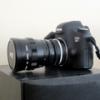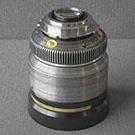
Brian Caldwell
-
Posts
153 -
Joined
-
Last visited
Reputation Activity
-
 Brian Caldwell got a reaction from Timotheus in Elliptical/Oval Bokeh Explained
Brian Caldwell got a reaction from Timotheus in Elliptical/Oval Bokeh Explained
Apologies in advance if this is widely known. Personally, I've never found a really good explanation of why front anamorphs produce oval bokeh and rear anamorphs don't, despite reading my fair share of patents, technical papers, internet gossip and the like. Feeling that my own understanding needed some firming up I finally set up some paraxial models and went through the math in gory detail. It all boils down to how front and rear converters alter (or don't alter) the f/#, and basic DOF type circle of confusion calculations. It has nothing to do with higher order aberrations, or the shape of the front lens, or various mechanical aspects of the lens.
Briefly:
1) A front anamorph is just a special case of a front afocal attachment, and as a result it preserves the f/# of the lens its attached to. With an anamorphic front lens the focal length is shorter in the powered axis than in the non-powered axis. For example, consider a 2:1 anamorph attached to a 100mm f/2 spherical lens. In this case the net focal length is 50mm in the powered axis and 100mm in the non-powered axis, but in both cases the aperture remains f/2. If you venture into the weeds to do circle of confusion calculations for a given object-space defocus you discover that a de-focused point source evaluated at the image plane is an ellipse with an aspect ratio of 4:1. However, you only need to de-squeeze the image by 2x to correct the in-focus geometry, so you are left with de-focused ellipses with an aspect ratio of 2:1.
2) A rear anamorph is just a special case of a rear-mounted teleconverter, and as a result it *does not* preserve the f/# of the lens its attached to. In particular, in the powered axis the aperture becomes slower. For example, consider an 50mm f/2 spherical lens with a 2x rear anamorph. Here the net focal length is 100mm in the powered axis, but the aperture has dropped to f/4, and is still 50mm f/2 in the non-powered axis. When you do the circle of confusion calculations with object-space defocus you find the on-sensor defocused image to be an ellipse with a 2:1 aspect ratio. When you desqueeze by 2x this defocus ellipse becomes a perfect circle.
Bottom Line: Rear anamorphs have circular bokeh because they *don't* preserve the f/# of the spherical lens in both axes, while front anamorphs have elliptical bokeh because they *do* preserve the f/# of the spherical lens in both axes.
-
 Brian Caldwell got a reaction from Tito Ferradans in Elliptical/Oval Bokeh Explained
Brian Caldwell got a reaction from Tito Ferradans in Elliptical/Oval Bokeh Explained
Apologies in advance if this is widely known. Personally, I've never found a really good explanation of why front anamorphs produce oval bokeh and rear anamorphs don't, despite reading my fair share of patents, technical papers, internet gossip and the like. Feeling that my own understanding needed some firming up I finally set up some paraxial models and went through the math in gory detail. It all boils down to how front and rear converters alter (or don't alter) the f/#, and basic DOF type circle of confusion calculations. It has nothing to do with higher order aberrations, or the shape of the front lens, or various mechanical aspects of the lens.
Briefly:
1) A front anamorph is just a special case of a front afocal attachment, and as a result it preserves the f/# of the lens its attached to. With an anamorphic front lens the focal length is shorter in the powered axis than in the non-powered axis. For example, consider a 2:1 anamorph attached to a 100mm f/2 spherical lens. In this case the net focal length is 50mm in the powered axis and 100mm in the non-powered axis, but in both cases the aperture remains f/2. If you venture into the weeds to do circle of confusion calculations for a given object-space defocus you discover that a de-focused point source evaluated at the image plane is an ellipse with an aspect ratio of 4:1. However, you only need to de-squeeze the image by 2x to correct the in-focus geometry, so you are left with de-focused ellipses with an aspect ratio of 2:1.
2) A rear anamorph is just a special case of a rear-mounted teleconverter, and as a result it *does not* preserve the f/# of the lens its attached to. In particular, in the powered axis the aperture becomes slower. For example, consider an 50mm f/2 spherical lens with a 2x rear anamorph. Here the net focal length is 100mm in the powered axis, but the aperture has dropped to f/4, and is still 50mm f/2 in the non-powered axis. When you do the circle of confusion calculations with object-space defocus you find the on-sensor defocused image to be an ellipse with a 2:1 aspect ratio. When you desqueeze by 2x this defocus ellipse becomes a perfect circle.
Bottom Line: Rear anamorphs have circular bokeh because they *don't* preserve the f/# of the spherical lens in both axes, while front anamorphs have elliptical bokeh because they *do* preserve the f/# of the spherical lens in both axes.
-
 Brian Caldwell got a reaction from BrooklynDan in Elliptical/Oval Bokeh Explained
Brian Caldwell got a reaction from BrooklynDan in Elliptical/Oval Bokeh Explained
Apologies in advance if this is widely known. Personally, I've never found a really good explanation of why front anamorphs produce oval bokeh and rear anamorphs don't, despite reading my fair share of patents, technical papers, internet gossip and the like. Feeling that my own understanding needed some firming up I finally set up some paraxial models and went through the math in gory detail. It all boils down to how front and rear converters alter (or don't alter) the f/#, and basic DOF type circle of confusion calculations. It has nothing to do with higher order aberrations, or the shape of the front lens, or various mechanical aspects of the lens.
Briefly:
1) A front anamorph is just a special case of a front afocal attachment, and as a result it preserves the f/# of the lens its attached to. With an anamorphic front lens the focal length is shorter in the powered axis than in the non-powered axis. For example, consider a 2:1 anamorph attached to a 100mm f/2 spherical lens. In this case the net focal length is 50mm in the powered axis and 100mm in the non-powered axis, but in both cases the aperture remains f/2. If you venture into the weeds to do circle of confusion calculations for a given object-space defocus you discover that a de-focused point source evaluated at the image plane is an ellipse with an aspect ratio of 4:1. However, you only need to de-squeeze the image by 2x to correct the in-focus geometry, so you are left with de-focused ellipses with an aspect ratio of 2:1.
2) A rear anamorph is just a special case of a rear-mounted teleconverter, and as a result it *does not* preserve the f/# of the lens its attached to. In particular, in the powered axis the aperture becomes slower. For example, consider an 50mm f/2 spherical lens with a 2x rear anamorph. Here the net focal length is 100mm in the powered axis, but the aperture has dropped to f/4, and is still 50mm f/2 in the non-powered axis. When you do the circle of confusion calculations with object-space defocus you find the on-sensor defocused image to be an ellipse with a 2:1 aspect ratio. When you desqueeze by 2x this defocus ellipse becomes a perfect circle.
Bottom Line: Rear anamorphs have circular bokeh because they *don't* preserve the f/# of the spherical lens in both axes, while front anamorphs have elliptical bokeh because they *do* preserve the f/# of the spherical lens in both axes.
-
 Brian Caldwell got a reaction from Bioskop.Inc in Elliptical/Oval Bokeh Explained
Brian Caldwell got a reaction from Bioskop.Inc in Elliptical/Oval Bokeh Explained
Apologies in advance if this is widely known. Personally, I've never found a really good explanation of why front anamorphs produce oval bokeh and rear anamorphs don't, despite reading my fair share of patents, technical papers, internet gossip and the like. Feeling that my own understanding needed some firming up I finally set up some paraxial models and went through the math in gory detail. It all boils down to how front and rear converters alter (or don't alter) the f/#, and basic DOF type circle of confusion calculations. It has nothing to do with higher order aberrations, or the shape of the front lens, or various mechanical aspects of the lens.
Briefly:
1) A front anamorph is just a special case of a front afocal attachment, and as a result it preserves the f/# of the lens its attached to. With an anamorphic front lens the focal length is shorter in the powered axis than in the non-powered axis. For example, consider a 2:1 anamorph attached to a 100mm f/2 spherical lens. In this case the net focal length is 50mm in the powered axis and 100mm in the non-powered axis, but in both cases the aperture remains f/2. If you venture into the weeds to do circle of confusion calculations for a given object-space defocus you discover that a de-focused point source evaluated at the image plane is an ellipse with an aspect ratio of 4:1. However, you only need to de-squeeze the image by 2x to correct the in-focus geometry, so you are left with de-focused ellipses with an aspect ratio of 2:1.
2) A rear anamorph is just a special case of a rear-mounted teleconverter, and as a result it *does not* preserve the f/# of the lens its attached to. In particular, in the powered axis the aperture becomes slower. For example, consider an 50mm f/2 spherical lens with a 2x rear anamorph. Here the net focal length is 100mm in the powered axis, but the aperture has dropped to f/4, and is still 50mm f/2 in the non-powered axis. When you do the circle of confusion calculations with object-space defocus you find the on-sensor defocused image to be an ellipse with a 2:1 aspect ratio. When you desqueeze by 2x this defocus ellipse becomes a perfect circle.
Bottom Line: Rear anamorphs have circular bokeh because they *don't* preserve the f/# of the spherical lens in both axes, while front anamorphs have elliptical bokeh because they *do* preserve the f/# of the spherical lens in both axes.
-
 Brian Caldwell got a reaction from Vladimir in Elliptical/Oval Bokeh Explained
Brian Caldwell got a reaction from Vladimir in Elliptical/Oval Bokeh Explained
Apologies in advance if this is widely known. Personally, I've never found a really good explanation of why front anamorphs produce oval bokeh and rear anamorphs don't, despite reading my fair share of patents, technical papers, internet gossip and the like. Feeling that my own understanding needed some firming up I finally set up some paraxial models and went through the math in gory detail. It all boils down to how front and rear converters alter (or don't alter) the f/#, and basic DOF type circle of confusion calculations. It has nothing to do with higher order aberrations, or the shape of the front lens, or various mechanical aspects of the lens.
Briefly:
1) A front anamorph is just a special case of a front afocal attachment, and as a result it preserves the f/# of the lens its attached to. With an anamorphic front lens the focal length is shorter in the powered axis than in the non-powered axis. For example, consider a 2:1 anamorph attached to a 100mm f/2 spherical lens. In this case the net focal length is 50mm in the powered axis and 100mm in the non-powered axis, but in both cases the aperture remains f/2. If you venture into the weeds to do circle of confusion calculations for a given object-space defocus you discover that a de-focused point source evaluated at the image plane is an ellipse with an aspect ratio of 4:1. However, you only need to de-squeeze the image by 2x to correct the in-focus geometry, so you are left with de-focused ellipses with an aspect ratio of 2:1.
2) A rear anamorph is just a special case of a rear-mounted teleconverter, and as a result it *does not* preserve the f/# of the lens its attached to. In particular, in the powered axis the aperture becomes slower. For example, consider an 50mm f/2 spherical lens with a 2x rear anamorph. Here the net focal length is 100mm in the powered axis, but the aperture has dropped to f/4, and is still 50mm f/2 in the non-powered axis. When you do the circle of confusion calculations with object-space defocus you find the on-sensor defocused image to be an ellipse with a 2:1 aspect ratio. When you desqueeze by 2x this defocus ellipse becomes a perfect circle.
Bottom Line: Rear anamorphs have circular bokeh because they *don't* preserve the f/# of the spherical lens in both axes, while front anamorphs have elliptical bokeh because they *do* preserve the f/# of the spherical lens in both axes.
-
 Brian Caldwell got a reaction from jase in Elliptical/Oval Bokeh Explained
Brian Caldwell got a reaction from jase in Elliptical/Oval Bokeh Explained
Apologies in advance if this is widely known. Personally, I've never found a really good explanation of why front anamorphs produce oval bokeh and rear anamorphs don't, despite reading my fair share of patents, technical papers, internet gossip and the like. Feeling that my own understanding needed some firming up I finally set up some paraxial models and went through the math in gory detail. It all boils down to how front and rear converters alter (or don't alter) the f/#, and basic DOF type circle of confusion calculations. It has nothing to do with higher order aberrations, or the shape of the front lens, or various mechanical aspects of the lens.
Briefly:
1) A front anamorph is just a special case of a front afocal attachment, and as a result it preserves the f/# of the lens its attached to. With an anamorphic front lens the focal length is shorter in the powered axis than in the non-powered axis. For example, consider a 2:1 anamorph attached to a 100mm f/2 spherical lens. In this case the net focal length is 50mm in the powered axis and 100mm in the non-powered axis, but in both cases the aperture remains f/2. If you venture into the weeds to do circle of confusion calculations for a given object-space defocus you discover that a de-focused point source evaluated at the image plane is an ellipse with an aspect ratio of 4:1. However, you only need to de-squeeze the image by 2x to correct the in-focus geometry, so you are left with de-focused ellipses with an aspect ratio of 2:1.
2) A rear anamorph is just a special case of a rear-mounted teleconverter, and as a result it *does not* preserve the f/# of the lens its attached to. In particular, in the powered axis the aperture becomes slower. For example, consider an 50mm f/2 spherical lens with a 2x rear anamorph. Here the net focal length is 100mm in the powered axis, but the aperture has dropped to f/4, and is still 50mm f/2 in the non-powered axis. When you do the circle of confusion calculations with object-space defocus you find the on-sensor defocused image to be an ellipse with a 2:1 aspect ratio. When you desqueeze by 2x this defocus ellipse becomes a perfect circle.
Bottom Line: Rear anamorphs have circular bokeh because they *don't* preserve the f/# of the spherical lens in both axes, while front anamorphs have elliptical bokeh because they *do* preserve the f/# of the spherical lens in both axes.
-
 Brian Caldwell got a reaction from Zak Forsman in Elliptical/Oval Bokeh Explained
Brian Caldwell got a reaction from Zak Forsman in Elliptical/Oval Bokeh Explained
Apologies in advance if this is widely known. Personally, I've never found a really good explanation of why front anamorphs produce oval bokeh and rear anamorphs don't, despite reading my fair share of patents, technical papers, internet gossip and the like. Feeling that my own understanding needed some firming up I finally set up some paraxial models and went through the math in gory detail. It all boils down to how front and rear converters alter (or don't alter) the f/#, and basic DOF type circle of confusion calculations. It has nothing to do with higher order aberrations, or the shape of the front lens, or various mechanical aspects of the lens.
Briefly:
1) A front anamorph is just a special case of a front afocal attachment, and as a result it preserves the f/# of the lens its attached to. With an anamorphic front lens the focal length is shorter in the powered axis than in the non-powered axis. For example, consider a 2:1 anamorph attached to a 100mm f/2 spherical lens. In this case the net focal length is 50mm in the powered axis and 100mm in the non-powered axis, but in both cases the aperture remains f/2. If you venture into the weeds to do circle of confusion calculations for a given object-space defocus you discover that a de-focused point source evaluated at the image plane is an ellipse with an aspect ratio of 4:1. However, you only need to de-squeeze the image by 2x to correct the in-focus geometry, so you are left with de-focused ellipses with an aspect ratio of 2:1.
2) A rear anamorph is just a special case of a rear-mounted teleconverter, and as a result it *does not* preserve the f/# of the lens its attached to. In particular, in the powered axis the aperture becomes slower. For example, consider an 50mm f/2 spherical lens with a 2x rear anamorph. Here the net focal length is 100mm in the powered axis, but the aperture has dropped to f/4, and is still 50mm f/2 in the non-powered axis. When you do the circle of confusion calculations with object-space defocus you find the on-sensor defocused image to be an ellipse with a 2:1 aspect ratio. When you desqueeze by 2x this defocus ellipse becomes a perfect circle.
Bottom Line: Rear anamorphs have circular bokeh because they *don't* preserve the f/# of the spherical lens in both axes, while front anamorphs have elliptical bokeh because they *do* preserve the f/# of the spherical lens in both axes.
-
 Brian Caldwell got a reaction from ken in Elliptical/Oval Bokeh Explained
Brian Caldwell got a reaction from ken in Elliptical/Oval Bokeh Explained
Apologies in advance if this is widely known. Personally, I've never found a really good explanation of why front anamorphs produce oval bokeh and rear anamorphs don't, despite reading my fair share of patents, technical papers, internet gossip and the like. Feeling that my own understanding needed some firming up I finally set up some paraxial models and went through the math in gory detail. It all boils down to how front and rear converters alter (or don't alter) the f/#, and basic DOF type circle of confusion calculations. It has nothing to do with higher order aberrations, or the shape of the front lens, or various mechanical aspects of the lens.
Briefly:
1) A front anamorph is just a special case of a front afocal attachment, and as a result it preserves the f/# of the lens its attached to. With an anamorphic front lens the focal length is shorter in the powered axis than in the non-powered axis. For example, consider a 2:1 anamorph attached to a 100mm f/2 spherical lens. In this case the net focal length is 50mm in the powered axis and 100mm in the non-powered axis, but in both cases the aperture remains f/2. If you venture into the weeds to do circle of confusion calculations for a given object-space defocus you discover that a de-focused point source evaluated at the image plane is an ellipse with an aspect ratio of 4:1. However, you only need to de-squeeze the image by 2x to correct the in-focus geometry, so you are left with de-focused ellipses with an aspect ratio of 2:1.
2) A rear anamorph is just a special case of a rear-mounted teleconverter, and as a result it *does not* preserve the f/# of the lens its attached to. In particular, in the powered axis the aperture becomes slower. For example, consider an 50mm f/2 spherical lens with a 2x rear anamorph. Here the net focal length is 100mm in the powered axis, but the aperture has dropped to f/4, and is still 50mm f/2 in the non-powered axis. When you do the circle of confusion calculations with object-space defocus you find the on-sensor defocused image to be an ellipse with a 2:1 aspect ratio. When you desqueeze by 2x this defocus ellipse becomes a perfect circle.
Bottom Line: Rear anamorphs have circular bokeh because they *don't* preserve the f/# of the spherical lens in both axes, while front anamorphs have elliptical bokeh because they *do* preserve the f/# of the spherical lens in both axes.
-
 Brian Caldwell got a reaction from tdonovic in Need advise, going the Speedboster way or not? (GH4)
Brian Caldwell got a reaction from tdonovic in Need advise, going the Speedboster way or not? (GH4)
I think a lot depends on how much you need lens speed, and how important the speed vs. size/weight tradeoff is to you. The new Panasonic 12/1.4 is no doubt a nice lens, and it looks pretty compact, but a Speed Booster XL on an 18-35 Sigma will give you an 11.5-22.4mm f/1.1 with excellent wide-open sharpness. In this case the native lens would make more sense if size/weight is more important than speed, and if you don't plan to use a Speed Booster on other lenses. On the other hand, a truly sharp f/1.1 zoom can come in pretty handy!
-
 Brian Caldwell got a reaction from jcs in Hasselblad mirrorless camera
Brian Caldwell got a reaction from jcs in Hasselblad mirrorless camera
"DOF falloff" seems like a really poor term. How about simply "defocus", or perhaps "MTF as a function of defocus" - which I think is what people actually mean. In optics this is referred to as "through-focus MTF", and its a standard and useful way to characterize a design. It will vary from design to design because it is strongly aberration dependent, but it has nothing to do with sensor size.
One advantage that larger formats have is that you can use a smaller relative aperture to achieve a given DOF. Since aberration correction tends to be very non-linear with respect to f/# you often wind up with better correction on a larger format. For instance, I used to shoot 11x14" film a fair amount, and aside from an advantage in film grain it allowed me to shoot at f/16 instead of the ~f/1.4 I would have had to use on 24x36 format to achieve an equivalent picture. Focal lengths scaled accordingly, naturally. At f/16 the ultra large format lens was nearly diffraction-limited, whereas a small format lens at f/1.4 is nowhere near that limit. Of course, as you depart from such extremes in aperture any potential optical differences between large and small formats begin to disappear, and these differences are further minimized by improved sensor quality. So that ridiculously huge view camera stays on the shelf these days!
Regarding the argument about whether a long lens on a large format has less perspective distortion than a proportionally scaled lens on a smaller format, the answer is "no". In terms of perspective and geometry, all lenses mimic the behavior of simple pinhole cameras - with the possible exception of rectilinear distortion which is generally a non-issue. One other thing to be aware of is that larger formats require a larger magnification, which essentially means you are using a longer lens than you may think you are for close-ups. For example, when shooting close portraits on 11x14" I was typically shooting at around -1x magnification, which effectively doubles the length of the lens. However, when you take this effect into account any potential discrepancies go away, and you are left with the stark reality that larger formats really don't offer any special "magic".
-
 Brian Caldwell got a reaction from jcs in Hasselblad mirrorless camera
Brian Caldwell got a reaction from jcs in Hasselblad mirrorless camera
Perhaps I could call such a product "The Naked Emperor Focal Reducer"? At least then I could sleep at night. I thought Kipon announced one of these, but it still seems to be vaporware.
To be clear, adding a focal reducer to a medium format lens to convert it to a 24x36 format lens will only result in a slowish FF lens. That's because medium format lenses tend to have very conservative designs and are very slow to begin with. I can't think of a single MF lens + focal reducer combination that would be a compelling new addition to the FF optical repertoire. As you have correctly implied, there is no magic to be found here.
-
 Brian Caldwell got a reaction from richg101 in Super anamorphic project
Brian Caldwell got a reaction from richg101 in Super anamorphic project
Two afocal attachments in series should have significantly better image quality than a single shorter one with the same total squeeze ratio.
-
 Brian Caldwell got a reaction from Andy Zou in Easy place to find lens construction diagrams to see distance from entrance pupil?
Brian Caldwell got a reaction from Andy Zou in Easy place to find lens construction diagrams to see distance from entrance pupil?
The attached PDF file contains some of the data I've measured and collected for various lenses. EFL is the paraxial focal length, EXPP is the exit pupil distance measured from the image plane in air (positive value means pupil is towards the object from the image), ENPP is the entrance pupil distance measured from the first glass surface (positive value means the entrance pupil is towards the image plane from the first surface), and BFL is the distance from the rear glass surface to the image plane measured in air. All measurements are in millimeters.LensData.pdfLensData.pdf
-

-

-
 Brian Caldwell got a reaction from Caleb Genheimer in 1.79x Squeeze Anamorphic
Brian Caldwell got a reaction from Caleb Genheimer in 1.79x Squeeze Anamorphic
The responses here have been very thoughtful, and have given me much to consider. I may modify my product direction a bit, but on the whole, it seems that my ideas aren't entirely crazy.
-
 Brian Caldwell got a reaction from Xavier Plagaro Mussard in Canon 18-80mm f4
Brian Caldwell got a reaction from Xavier Plagaro Mussard in Canon 18-80mm f4
Just add a 0.71x SB to your 24-105 and you have a 17-75mm f/2.8
-
 Brian Caldwell got a reaction from AaronChicago in Canon 18-80mm f4
Brian Caldwell got a reaction from AaronChicago in Canon 18-80mm f4
Just add a 0.71x SB to your 24-105 and you have a 17-75mm f/2.8
-
 Brian Caldwell got a reaction from Nikkor in Canon 18-80mm f4
Brian Caldwell got a reaction from Nikkor in Canon 18-80mm f4
Just add a 0.71x SB to your 24-105 and you have a 17-75mm f/2.8
-
 Brian Caldwell got a reaction from Bioskop.Inc in Where did all the single focus solutions come from?
Brian Caldwell got a reaction from Bioskop.Inc in Where did all the single focus solutions come from?
If you're doing a wide angle Iscorama-style attachment with a large diameter front, then my statement about the variable diopter being "easy" obviously needs amendment, since the mechanics does become much more difficult. Although I'm a big fan of big lenses, they tend to require exotic/expensive items like precision linear bearings to keep them moving straight and without play.
Maybe not entirely relevant here, but its interesting the the new Cooke anamorphics also use a pretty basic variable diopter focusing scheme, although the net power is negative rather than afocal: http://pdfaiw.uspto.gov/.aiw?PageNum=0&docid=20140300973&IDKey=735679DAC5C4&HomeUrl=http%3A%2F%2Fappft.uspto.gov%2Fnetacgi%2Fnph-Parser%3FSect1%3DPTO2%2526Sect2%3DHITOFF%2526p%3D1%2526u%3D%25252Fnetahtml%25252FPTO%25252Fsearch-bool.html%2526r%3D5%2526f%3DG%2526l%3D50%2526co1%3DAND%2526d%3DPG01%2526s1%3Diain.IN.%2526s2%3Dneil.IN.%2526OS%3DIN%2Fiain%252BAND%252BIN%2Fneil%2526RS%3DIN%2Fiain%252BAND%252BIN%2Fneil
-
 Brian Caldwell got a reaction from Bioskop.Inc in Where did all the single focus solutions come from?
Brian Caldwell got a reaction from Bioskop.Inc in Where did all the single focus solutions come from?
I think the death of anamorphic film projection and the resulting appearance of dirt cheap anamorphic projection lenses (e.g. Schneider Cinelux etc.) was also an important factor. After all, the variable diopter part is easy, its the cylindrical lenses that are hard to make. It will be interesting to see what happens once the supply of grossly underpriced projection lenses dries up.
-
 Brian Caldwell got a reaction from Xavier Plagaro Mussard in Where did all the single focus solutions come from?
Brian Caldwell got a reaction from Xavier Plagaro Mussard in Where did all the single focus solutions come from?
Note, at the time the Isco patent was issued in 1970 the law was that the lifetime of a patent was 17 years from the date of issue. When a patent expires the time-limited right of the assignee to a monopoly also expires, and the technology becomes part of the public domain. So, its been completely legal to manufacture and sell Iscorama style systems since 1987, almost 30 years now!
-
 Brian Caldwell got a reaction from richg101 in Where did all the single focus solutions come from?
Brian Caldwell got a reaction from richg101 in Where did all the single focus solutions come from?
If you're doing a wide angle Iscorama-style attachment with a large diameter front, then my statement about the variable diopter being "easy" obviously needs amendment, since the mechanics does become much more difficult. Although I'm a big fan of big lenses, they tend to require exotic/expensive items like precision linear bearings to keep them moving straight and without play.
Maybe not entirely relevant here, but its interesting the the new Cooke anamorphics also use a pretty basic variable diopter focusing scheme, although the net power is negative rather than afocal: http://pdfaiw.uspto.gov/.aiw?PageNum=0&docid=20140300973&IDKey=735679DAC5C4&HomeUrl=http%3A%2F%2Fappft.uspto.gov%2Fnetacgi%2Fnph-Parser%3FSect1%3DPTO2%2526Sect2%3DHITOFF%2526p%3D1%2526u%3D%25252Fnetahtml%25252FPTO%25252Fsearch-bool.html%2526r%3D5%2526f%3DG%2526l%3D50%2526co1%3DAND%2526d%3DPG01%2526s1%3Diain.IN.%2526s2%3Dneil.IN.%2526OS%3DIN%2Fiain%252BAND%252BIN%2Fneil%2526RS%3DIN%2Fiain%252BAND%252BIN%2Fneil
-
 Brian Caldwell got a reaction from richg101 in Where did all the single focus solutions come from?
Brian Caldwell got a reaction from richg101 in Where did all the single focus solutions come from?
I think the death of anamorphic film projection and the resulting appearance of dirt cheap anamorphic projection lenses (e.g. Schneider Cinelux etc.) was also an important factor. After all, the variable diopter part is easy, its the cylindrical lenses that are hard to make. It will be interesting to see what happens once the supply of grossly underpriced projection lenses dries up.
-
 Brian Caldwell got a reaction from Tito Ferradans in Where did all the single focus solutions come from?
Brian Caldwell got a reaction from Tito Ferradans in Where did all the single focus solutions come from?
Note, at the time the Isco patent was issued in 1970 the law was that the lifetime of a patent was 17 years from the date of issue. When a patent expires the time-limited right of the assignee to a monopoly also expires, and the technology becomes part of the public domain. So, its been completely legal to manufacture and sell Iscorama style systems since 1987, almost 30 years now!











